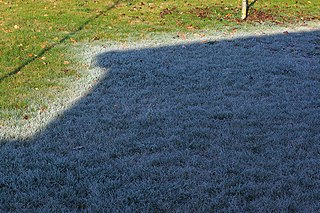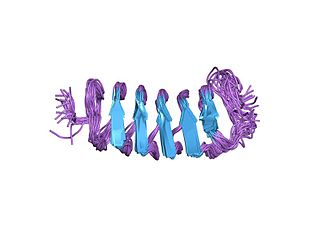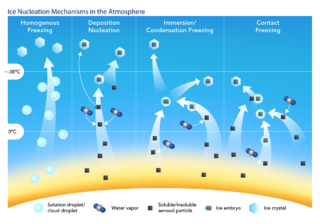Related Research Articles

Frost is a thin layer of ice on a solid surface, which forms from water vapor that deposits onto a freezing surface. Frost forms when the air contains more water vapor than it can normally hold at a specific temperature. The process is similar to the formation of dew, except it occurs below the freezing point of water typically without crossing through a liquid state.

Freezing is a phase transition in which a liquid turns into a solid when its temperature is lowered below its freezing point.
Cryobiology is the branch of biology that studies the effects of low temperatures on living things within Earth's cryosphere or in science. The word cryobiology is derived from the Greek words κρῧος [kryos], "cold", βίος [bios], "life", and λόγος [logos], "word". In practice, cryobiology is the study of biological material or systems at temperatures below normal. Materials or systems studied may include proteins, cells, tissues, organs, or whole organisms. Temperatures may range from moderately hypothermic conditions to cryogenic temperatures.

Supercooling, also known as undercooling, is the process of lowering the temperature of a liquid below its freezing point without it becoming a solid. As per the established international definition, supercooling means ‘cooling a substance below the normal freezing point without solidification’ While it can be achieved by different physical means, the postponed solidification is most often due to the absence of seed crystals or nuclei around which a crystal structure can form. The supercooling of water can be achieved without any special techniques other than chemical demineralization, down to −48.3 °C (−54.9 °F). Supercooled water can occur naturally, for example in the atmosphere, animals or plants.

In meteorology, precipitation is any product of the condensation of atmospheric water vapor that falls from clouds due to gravitational pull. The main forms of precipitation include drizzle, rain, sleet, snow, ice pellets, graupel and hail. Precipitation occurs when a portion of the atmosphere becomes saturated with water vapor, so that the water condenses and "precipitates" or falls. Thus, fog and mist are not precipitation; their water vapor does not condense sufficiently to precipitate, so fog and mist do not fall. Two processes, possibly acting together, can lead to air becoming saturated with water vapor: cooling the air or adding water vapor to the air. Precipitation forms as smaller droplets coalesce via collision with other rain drops or ice crystals within a cloud. Short, intense periods of rain in scattered locations are called showers.

Antifreeze proteins (AFPs) or ice structuring proteins refer to a class of polypeptides produced by certain animals, plants, fungi and bacteria that permit their survival in temperatures below the freezing point of water. AFPs bind to small ice crystals to inhibit the growth and recrystallization of ice that would otherwise be fatal. There is also increasing evidence that AFPs interact with mammalian cell membranes to protect them from cold damage. This work suggests the involvement of AFPs in cold acclimatization.

Psychrophiles or cryophiles are extremophilic organisms that are capable of growth and reproduction in low temperatures, ranging from −20 °C (−4 °F) to 20 °C (68 °F). They are found in places that are permanently cold, such as the polar regions and the deep sea. They can be contrasted with thermophiles, which are organisms that thrive at unusually high temperatures, and mesophiles at intermediate temperatures. Psychrophile is Greek for 'cold-loving', from Ancient Greek ψυχρός (psukhrós) 'cold, frozen'.
In physics and chemistry, flash freezing is the process whereby objects are rapidly frozen. This is done by subjecting them to cryogenic temperatures, or it can be done through direct contact with liquid nitrogen at −196 °C (−320.8 °F). It is commonly used in the food industry.

Rime ice forms when supercooled water droplets freeze onto surfaces. In the atmosphere, there are three basic types of rime ice:

In thermodynamics, nucleation is the first step in the formation of either a new thermodynamic phase or structure via self-assembly or self-organization within a substance or mixture. Nucleation is typically defined to be the process that determines how long an observer has to wait before the new phase or self-organized structure appears. For example, if a volume of water is cooled significantly below 0 °C, it will tend to freeze into ice, but volumes of water cooled only a few degrees below 0 °C often stay completely free of ice for long periods (supercooling). At these conditions, nucleation of ice is either slow or does not occur at all. However, at lower temperatures nucleation is fast, and ice crystals appear after little or no delay.

Snowmaking is the production of snow by forcing water and pressurized air through a "snow gun", also known as a "snow cannon". Snowmaking is mainly used at ski resorts to supplement natural snow. This allows ski resorts to improve the reliability of their snow cover and to extend their ski seasons from late autumn to early spring. Indoor ski slopes use snowmaking. They can generally do so year-round as they have climate-controlled environments.
Ice-minus bacteria is a common name given to a variant of the common bacterium Pseudomonas syringae. This strain of P. syringae lacks the ability to produce a certain surface protein, usually found on wild-type P. syringae. The "ice-plus" protein found on the outer bacterial cell wall acts as the nucleating centers for ice crystals. This facilitates ice formation, hence the designation "ice-plus". The ice-minus variant of P. syringae is a mutant, lacking the gene responsible for ice-nucleating surface protein production. This lack of surface protein provides a less favorable environment for ice formation. Both strains of P. syringae occur naturally, but recombinant DNA technology has allowed for the synthetic removal or alteration of specific genes, enabling the ice-minus strain to be created from the ice-plus strain in the lab.

Pseudomonas syringae is a rod-shaped, Gram-negative bacterium with polar flagella. As a plant pathogen, it can infect a wide range of species, and exists as over 50 different pathovars, all of which are available to researchers from international culture collections such as the NCPPB, ICMP, and others.
Pseudomonas viridiflava is a fluorescent, Gram-negative, soil bacterium that is pathogenic to plants. It was originally isolated from the dwarf or runner bean, in Switzerland. Based on 16S rRNA analysis, P. viridiflava has been placed in the P. syringae group. Following ribotypical analysis misidentified strains of Pseudomonas syringae pv. ribicola and Pseudomonas syringae pv. primulae were incorporated into this species. This pathogen causes bacterial blight of Kiwifruit.

Halo blight of bean is a bacterial disease caused by Pseudomonas syringae pv. phaseolicola. Halo blight’s pathogen is a gram-negative, aerobic, polar-flagellated and non-spore forming bacteria. This bacterial disease was first discovered in the early 1920s, and rapidly became the major disease of beans throughout the world. The disease favors the places where temperatures are moderate and plentiful inoculum is available.

Insect winter ecology describes the overwinter survival strategies of insects, which are in many respects more similar to those of plants than to many other animals, such as mammals and birds. Unlike those animals, which can generate their own heat internally (endothermic), insects must rely on external sources to provide their heat (ectothermic). Thus, insects persisting in winter weather must tolerate freezing or rely on other mechanisms to avoid freezing. Loss of enzymatic function and eventual freezing due to low temperatures daily threatens the livelihood of these organisms during winter. Not surprisingly, insects have evolved a number of strategies to deal with the rigors of winter temperatures in places where they would otherwise not survive.

An ice nucleus, also known as an ice nucleating particle (INP), is a particle which acts as the nucleus for the formation of an ice crystal in the atmosphere.
Pseudomonas protegens are widespread Gram-negative, plant-protecting bacteria. Some of the strains of this novel bacterial species previously belonged to P. fluorescens. They were reclassified since they seem to cluster separately from other fluorescent Pseudomonas species. P. protegens is phylogenetically related to the Pseudomonas species complexes P. fluorescens, P. chlororaphis, and P. syringae. The bacterial species characteristically produces the antimicrobial compounds pyoluteorin and 2,4-diacetylphloroglucinol (DAPG) which are active against various plant pathogens.
Freezing tolerance describes the ability of plants to withstand subzero temperatures through the formation of ice crystals in the xylem and intercellular space, or apoplast, of their cells. Freezing tolerance is enhanced as a gradual adaptation to low temperature through a process known as cold acclimation, which initiates the transition to prepare for subzero temperatures through alterations in rate of metabolism, hormone levels and sugars. Freezing tolerance is rapidly enhanced during the first days of the cold acclimation process when temperature drops. Depending on the plant species, maximum freezing tolerance can be reached after only two weeks of exposure to low temperatures. The ability to control intercellular ice formation during freezing is critical to the survival of freeze-tolerant plants. If intracellular ice forms, it could be lethal to the plant when adhesion between cellular membranes and walls occur. The process of freezing tolerance through cold acclimation is a two-stage mechanism:
Steven Earl Lindow is an American plant pathologist. He has researched the application of transgenic bacteria to prevent frost damage in crops as well as using bacteria to prevent russeting of fruit. He is a member of several scientific societies, including the National Academy of Sciences, and has been co-editor of the Annual Review of Phytopathology from 2015-2023.
References
- ↑ Prasanth., M.; Nachimuthu, Ramesh; Gothandam, K. M; Kathikeyan, Sivamangala; Shanthini, T. (February 2015). "Pseudomonas Syringae: An Overview and its future as a "Rain Making Bacteria"" (PDF). International Research Journal of Biological Sciences. 4 (2): 70–77.
- ↑ Morris, Cindy E., et al. “Bioprecipitation: A feedback cycle linking Earth history, ecosystem dynamics and land use through biological ice nucleators in the atmosphere.” Global Change Biology, vol. 20, no. 2, 2013, pp. 341–351, doi : 10.1111/gcb.12447.
- ↑ Brent Christner (28 February 2008). "LSU scientist finds evidence of 'rain-making' bacteria". American Association for the Advancement of Science . Retrieved 31 January 2011.
- 1 2 Christine Dell'Amore (12 January 2009). "Rainmaking Bacteria Ride Clouds to "Colonize" Earth?". National Geographic. Archived from the original on 12 May 2011. Retrieved 31 January 2011.
- ↑ Cilliers, C., Neveling, O., Tichapondwa, S. M., Chirwa, E. M. N., & Brink, H. G. (2022). “Microbial pb(ii)-bioprecipitation: Characterising Responsible Biotransformation Mechanisms.” Journal of Cleaner Production, 374, 133973. doi : 10.1016/j.jclepro.2022.133973
- ↑ Georgakopoulos,D.G. “Biological Ice Nucleators in Snow Samples from Greece.” Atmosphere 2021,12,1461. doi : 10.3390/atmos12111461
- ↑ Schiermeier, Quirin (2008-02-28). "'Rain-making' bacteria found around the world". Nature. doi: 10.1038/news.2008.632 . ISSN 0028-0836.
- ↑ Halsall, Mark. "Snomax: Need more snow?". Snow Grooming Magazine. Integrit Media Inc. Retrieved 2 September 2015.
- ↑ Chen, Huan, et al. “Pseudomonas syringae pathovars.” Trends in Microbiology, vol. 30, no. 9, 2022, pp. 912–913, doi : 10.1016/j.tim.2022.03.002.